 |
European VLBI Network
Newsletter
Number 15
September 2006 |
1. Call for
Proposals - Deadline 4 October 2006
Observing proposals are invited for the
EVN, a VLBI network of radio telescopes spread throughout Europe
and beyond, operated by an international Consortium of institutes.
The EVN is open to all astronomers. Use of the Network by
astronomers not specialised in the VLBI technique is encouraged.
The Joint Institute for VLBI
in Europe (JIVE) can provide support and
advice on project preparation, scheduling, correlation and
analysis.
EVN Observing Sessions in
2006-2007
2006 Session 3
|
Nov 16- Nov 30 |
6cm, 3.6cm |
2007 Session 1
|
Mar 01 - Mar 22 |
18/21cm, 6cm, 5cm, 1.3cm |
2007 Session 2
|
May 31 - Jun 20 |
6cm, 5cm, +... |
Proposals received by 4 October
2006 will be considered for scheduling in
Session 1, 2007 or later. Finalisation of the planned observing
wavelengths will depend on proposal pressure. Other wavelengths which
may be scheduled in 2007 are 90cm, 50cm, 30cm, 3.6cm, and 7mm.
Special features for Sessions
in 2006-2007
- Recording at 1 Gb/s (Mark
5A) is now possible for an increasing number of projects. It is planned
that this will become soon the standard observing mode for all
continuum EVN-only projects.
- MERLIN is now available for
joint EVN+MERLIN observations in all sessions, for any EVN wavelengths
which MERLIN supports (18/21cm, 6/5cm, 1.3cm). However, limited
resources during e-MERLIN construction mean that joint EVN+MERLIN will
be scheduled at no more than two of these bands (usually 18/21cm and
5/6cm) in any one session.
- The Arecibo telescope will
not be available during session 1, 2007.
Large projects
Most proposals request 12-48hrs
observing time. The EVN Program Committee (PC) also encourages larger
projects (>48 hrs); these will be subject to more detailed scrutiny,
and the EVN PC may, in some cases, attach conditions on the release of
the data.
How to submit
Complete a
coversheet and attach a scientific justification (maximum 2
pages). Up to 2 additional pages with diagrams (black and white only)
may be included; the total, including cover sheet, should not exceed 6
pages.
Submit to: Richard Porcas, EVN Scheduler, MPIfR, Auf dem
Huegel 69,
D 53121 BONN, GERMANY or by email to: proposevn@mpifr-bonn.mpg.de.
Deadlines: 23:59:59 UTC on 4 Oct 2006.
Additional information
The detailed
Call for Proposals has further information on Global VLBI,
EVN+MERLIN and guidelines for proposal submission.
The EVN
User Guide
describes the network and provides general information on its
capabilities.
The
EVN Status Table gives current antenna capabilities.
The On-line VLBI
catalogue lists sources observed by the EVN and Global VLBI.
2. Report fron the EVN
TOG
The
EVN TOG held a meeting on 23 - 24 March 2006 hosted by ASTRON in
Dwingeloo. On the first day a so-called mini-workshop at Westerbork was
offered for training in various aspects of VLBI operations at the
telescopes: Mark 5 recording system, amplitude calibration, Field
System operation, and an introduction to the EVN digital
baseband-converter project. The digital baseband-converters will
hopefully soon replace the old analog baseband-converters, which suffer
from lack of spare parts and are inferior to their digital counterparts
in many aspects. A working prototype was shown at the meeting.
Approximately
50 people attended the meeting. The minutes and various reports can be
found under
http://www.mpifr-bonn.mpg.de/div/vlbicor/tog_chair/togreps06/togminutes.txt and
http://www.mpifr-bonn.mpg.de/div/vlbicor/tog_chair/togreps06/index.html
The participants
of the mini-workshop gave a positive feedback. The presentations and
course material are provided on the Internet
http://www.mpifr-bonn.mpg.de/div/vlbicor/tog_chair/prog_ws_06.html so that they can
serve as reference material for the VLBI friends.
The EVN has
implemented (nearly) automatic "near real-time" fringe checks.
Typically data from the first observation in every frequency session
are transfered to JIVE where they get correlated and analyzed
automatically. The EVN stations can access the results a short time
after the data transfer has been completed. The next release of the
Field System, which controls the data acquisition at the antennas, will
have automatic transfer for those tests built in. The final aim will be
to fully automatically transfer, correlate and analyze data on a fringe
finder from every observation.
The improved
reliability of the network does not apply to experiments recorded on
tape which was still done for observations to be correlated at Socorro.
As a consequence the TOG decided to stop any tape recording for future
observing sessions provided the EVN directors agree and an arrangement
can be found with NRAO of how to handle global observations. In the
meantime the EVN directors have accepted this proposal and as a
consequence nearly all global VLBI observations will be correlated at
JIVE. For experiments which require the VLBA correlator some
compromises have to be made.
Even though the
schedule submission scheme remains unchanged for the observers, an
additional safeguard has been implemented against stations observing
different versions of a schedule. Observers still have to deposit
schedules no later than 3 weeks before the session on the vlbeer ftp
area. Schedules are "piped" through checks at JIVE and a selected
station. Only after successfully passing those checks which takes about
1 week can an experiment schedule be downloaded by the stations.
Effelsberg
single dish fluxes can be provided on a "best-effort" basis, on request
from PIs. (The fluxes of some calibrators are measured at every
session.) The accuracy depends on many factors such as the weather,
observing frequency (particularly at low frequencies, confusion and
extended source structure may be a problem). The PI must leave gaps in
the schedule and also should request single dish flux density
measurements via email/comments in the schedule.
Flux densities
from Westerbork local interferometry can also be provided, and no
special scheduling is needed. PIs should send a request to Foley for
these data.
The Mark 5B
system is available now. The software is expected to be operational in
the 2nd half of 2006. The deployment of Mark 5B is to be decided at the
next TOG meeting. An evaluation of the system will be done at JIVE. The
Mark 5B system is very interesting for the Mark 4 correlators as it has
the potential to make correlation more robust by replacing the old
so-called station units with newer and simpler hardware.
The increased
throughput at the JIVE correlator and the growth of the EVNdisk pool
have allowed more 1 Gbps observations to be scheduled. The Directors
have agreed to purchase the necessary disk space to allow all continuum
experiments to be recorded at 1 Gbps.
Walter Alef - MPIfR Bonn
3. JIVE and EXPReS's observations of the SMART-1 impact
JIVE coordinated
global radio observation of the SMART-1 final orbit and impact on 3
September 2006 with participation from five telescopes: Medicina (final
pass over Europe only), TIGO, ROEN, Hobart and ATCA. Researchers were
able to pinpoint the time of impact to 05:42:21:759 UT, with a signal last
received by Hobart at 05:42:22.394 UT.
As a test
of
EXPReS, 10 seconds of data was sent from TIGO via REUNA (Chile),
RedCLARA (South America), GÉANT2 (Europe) and SURFnet
(Netherlands)
with transfer rates of up to 8 Gbps.
Observations of
SMART-1's flight were conducted in May using Medicina, Metsahovi and Westerbork
telescopes, and in July with Westerbork, to test the VLBI setup. These
and the impact observation pave the way for future ground observation
of Lunar and planetary missions such as China's upcoming Chang-E'1
Lunar orbiter, scheduled to launch in 2007.
Kristine Yun -
JIVE
4.
The
DBBC backend started systematic
tests under observing conditions
The first complete DBBC system has been presented at the 4th IVS
General meeting in Concepcion (Chile) in January 2006. After his return
back to Italy an intensive observing campaign to test the
performance started with the baseline Noto - Medicina.
At present the DBBC is very similar to a standard MK4 or VLBA
terminal, but much more compact with dimensions similar to a MK5
recorder. The standard version can accept 4 IFs each in a wide band up
to 2.2 GHz and produce up to 64 channels (tracks equivalent) coming
from up to 16 independently tuned L&U SSB bands with 2-bit output
representation, for a maximum aggregate data rate of 2 Gbps on two VSI
connectors. Some new configuration modes will 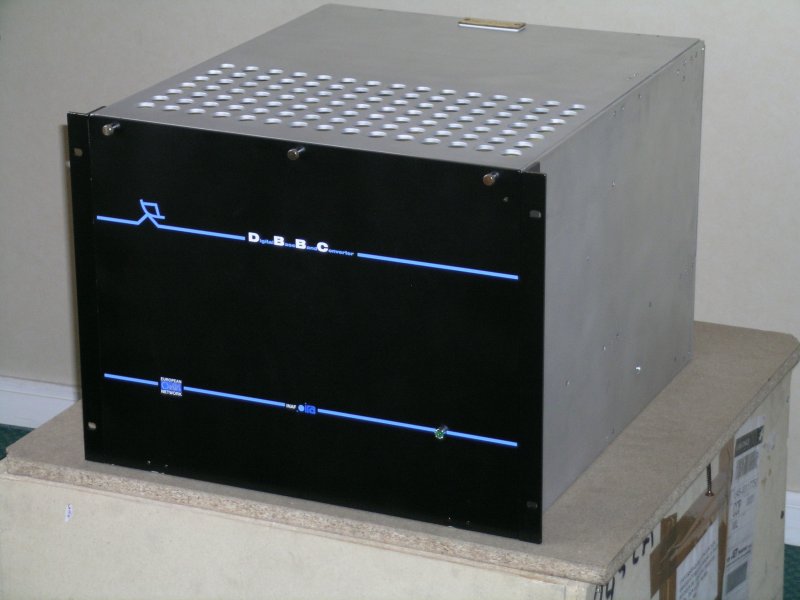 be soon developed like
the tuned bandwidth of 32 MHz with 64 MHz clock output. This mode, if
adopted with 16 CoreBoards, will produce a maximum aggregate data rate
of 4 Gbps on two VSI connectors. Multichannel configurations, with a
reduced number of Core Boards processing elements, are also under
development for future use.
be soon developed like
the tuned bandwidth of 32 MHz with 64 MHz clock output. This mode, if
adopted with 16 CoreBoards, will produce a maximum aggregate data rate
of 4 Gbps on two VSI connectors. Multichannel configurations, with a
reduced number of Core Boards processing elements, are also under
development for future use.
All modes are in a testing phase and will be qualified in field
tests during the coming months with the continuation of the observation
program.
Firmware upgrades, so as additional configurations for new modes will
be available by means of an automatic exploder server, set to maintain
the different units on the field up to date.
The DBBC is a completely programmable system so that its functionality
can be modified with simple commands. New possibilities have been
envisaged and will be developed in the near future. Some examples are:
high
resolution in time and frequency spectrometer, polarimeter,
pre-processing RFI mitigation. Moreover making use of some of its part
and a Metsahovi recording board, a new implementation of two digital
receivers operating in L band are in development for Effelsberg and
Noto.
A 'travel'
version
of the backend has been used in Evpatoria (Ukraine), for the test
observation of this future EVN Station, and fringes have been found
in the expected baselines of Evpatoria-Medicina and
Evpatoria-Westerbork. In the upcoming months a similar observation will
be realized in the other candidate EVN station, Irbene in Latvia.
Gino Tuccari - Istiituto di Radioastronomia/INAF Noto
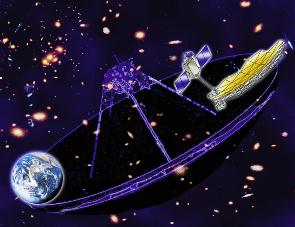 The
VSOP-2 project which was proposed last year was finaly approved
at JAXA
and then at the highest level governmental space committee.
VSOP-2 budget request
starting from April 2007 was submitted, and the the decision is expected to be
given in the end of December 2006.
The
VSOP-2 project which was proposed last year was finaly approved
at JAXA
and then at the highest level governmental space committee.
VSOP-2 budget request
starting from April 2007 was submitted, and the the decision is expected to be
given in the end of December 2006.
Current launch plan is February 2012, and
until then the spacecraft will be called Astro-G with the project name
VSOP-2. The 2006 fiscal year(started in April) is used for arrangements for the
formal project start with phase-A budget. VSOP-2 is the first ISAS
scientific space mission since JAXA was formed.
VSOP-2 European meeting was held at JIVE on June 15, and the next
meeting
in the spring of 2007 is being planned.
Hirax
Hirabayashi - JAXA
6. A new 6cm Receiver in
Medicina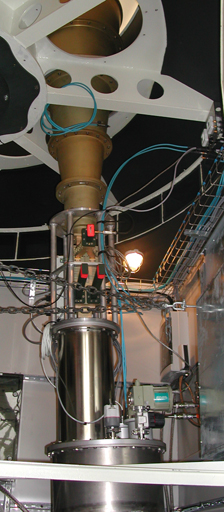
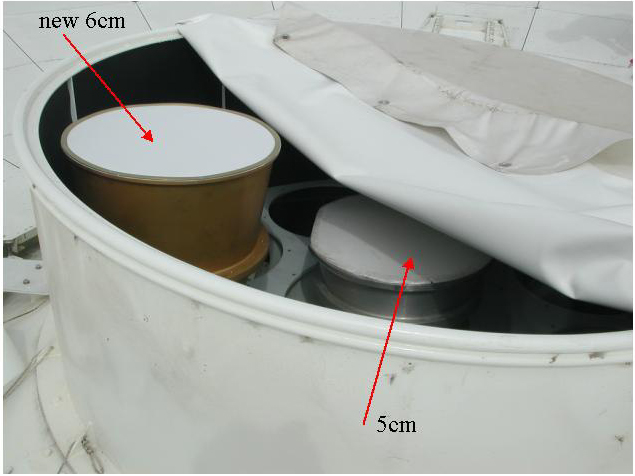
A new 6cm
receiver has
just been mounted on the VLBI parabolic antenna of the Medicina
station, improving the sensitivity of almost a factor of two with
respect to the old receiver..
It was designed in order
to show very good performances in a large bandwidth and with the best
performance in term of temperature noise and antenna gain (SEFD). It
uses a dual flare corrugated horn, a circular waveguide irises
polarizer and a square waveguide omt. The crosspolarization
performance has been optimized in the central part of the band, the
VLBI band.
A noise calibration
injection is provided via a square waveguide directional coupler.
Both polarizer and omt are
cryogenically cooled together with the LNAs.

In the following a brief
summary of the performances and characteristics:
Mounting: cassegrain
focus (Fig. 1 and 2)
Sky Band:
4.3-5.8GHz
Istantaneous
band (IF):
100-500MHz or 100-900MHz, both tunable everywhere in the sky band
Output Channels:
Left and
Right Circular Polarization
Measured LNA
Noise
Temperature: 7-8K through band
Measured
Receiver Noise
Temperature (laboratory): 12-14K through band (Fig.3)
Measured
Receiver System
Noise Temperature (mounted on antenna): 27K at El=70.
-It comprises
about 8K from sky (atmosphere contribution = 5K) and 5K due to
spillover.
Measured Antenna
Gain:
0.16K/Jy at 4.3-5.3GHz, 0.15K/Jy at 5.3-5.8GHz
Measured
Crosspol level
(on axis) < -33dB (<2% pollution) in the VLBI band
Measured
Percentage of
Pcal Amplitude: 4% Tsys
Alessandro
Orfei - Istituto di Radioastronomia/INAF Bologna
7. First
10 Gbps installed at Metsäovi
Radio Observatory
Metsäovi
Radio Observatory in Kirkkonummi, Southern Finland, is the first
Finnish research institute to have a network connection, whose
bandwidth exceeds 1 Gbps. It is also the first radio observatory in the
world connected at 10 Gbps.
As the only observatory in Finland operating a radio telescope
dedicated to radio astronomy, the MRO routinely performs a wide
range of radio astronomical observations, such as long-term monitoring
of active galactic nuclei, mapping and tracking of flares and active
regions of the Sun, and global collaborative in VLBI observations.
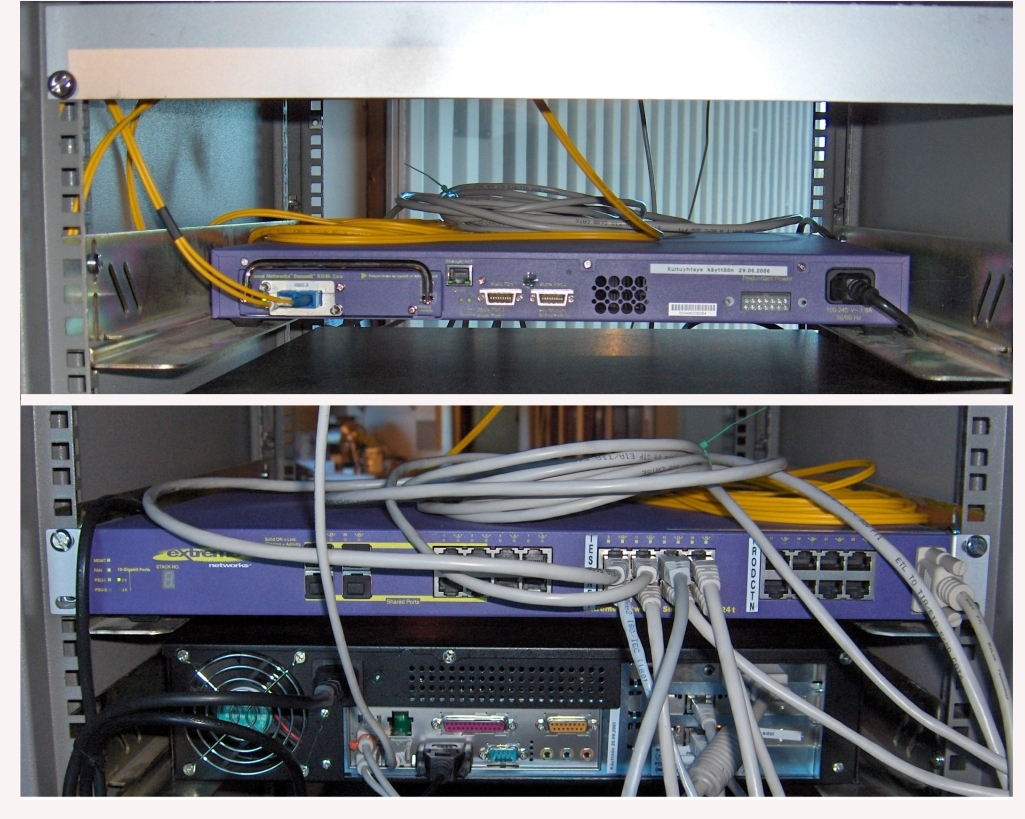
Routine data rates in today's VLBI observations lie between 256 and
1,024 Mbps, with the trials already on their way at 2 and 4 Gbps. "The
unsatiable need for bandwidth makes VLBI one of the most interesting
and demanding precursory multi-Gbps Internet applications", says
laboratory manager Ari Mujunen.
Dark fiber made this possible
Senior researcher scientist Jouko Ritakari
explains, "We have longed for this connection for several years, but
until now the cost was too high for a small laboratory that only has 20
employees. The telecom companies wanted to rent only connections that
had their own active equipment."
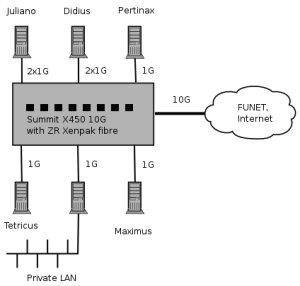
The situation changed at the end of last year. We receive funding
to rent a dark fiber connection to the Funet hub and the local
telephone company was willing to provide it. Jouko Ritakari continues,
"Originally we intended to have one or two 1 Gbps Ethernet connections.
However, when we asked for tenders it became clear that we could have a 10 Gbps
equipment for dark fiber at essentially the same price. So we could not
refuse the chance to get 10 Gbps connection. Now we are in very good
position to achieve new internationally interesting results in the
field of eVLBI."
Installing and configuring the fiber connection
Installation of new 10 Gbps equipment went
surprisingly smoothly, the equipment arrived at noon on 29.06.2006 and
it was working four hours later. The actual layout of the network
configuration is oriented to allow to use almost the full
capacities of the 10 Gbps connection to the VLBI test-machines Five
VSIB computers can make VLBI observations and transfer data up to 1
Gbps or even 2 Gbps rates. In addition, one tenth of the capacity is
booked for the internal traffic generated by the users.
One of the first VLBI experiments transferred to JIVE for correlation
was an experimental ESA Smart-1 lunar probe spacecraft position VLBI
tracking observation. eVLBI transfers of joint observations of an
Italian, a Dutch, and a Finnish radio telescope enabled quick and
successful verification of a new software-based correlation processing
technique developed at JIVE.
Guifré Molera Calvés,
Ari Mujunen, Jouko Ritakari, Jan Wagner - Metsähovi Radio
Observatory
2006 Session
2: June 1 - June 19 Wavelengths:
30cm 18/20cm 5cm 6cm(+MERLIN)
This session
proved difficult to schedule due to the restricted
availability of the GBT, Arecibo, Jodrell_LT and the Effelsberg
telescope (which was unavailable during daylight hours on work days
from 12 June onwards). A further complication was the need to
accomodate one highly-rated project requiring simultaneously the UHF
receiver in Effelsberg and L-Band receivers elsewhere, including GBT
and Arecibo. However, in the end the session proved to be disk-limited,
and only projects with ratings ~1.5 could be scheduled (all such
eligible projects were).
Five of the 14
scheduled projects were global. Only one project
was correlated at the VLBA correlator. All EVN observatories
recorded using MK5A disks.
One "short
observation" request was received on 20 April. (Such
requests are for exploratory observations limited to 4h and minimal
disk and telescope resources.) This was approved by the EVNPC Chair and
it proved possible to accomodate this in a suitable gap in the main
schedule.
A second Target
of Opportunity proposal to observe RS Ophiuchi was
submitted to the EVN on 26 April, requesting observing time either
before (preferred) or within Session 2. Due to the willingness of
observatories to accomodate this request it proved possible to schedule
this at 9 stations on May 15/16, 2 weeks before the start of the
session.
Richard Porcas - EVN
Scheduler


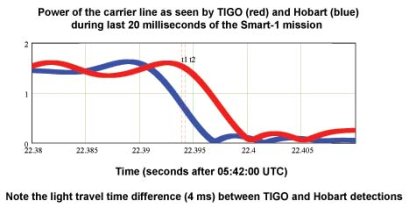
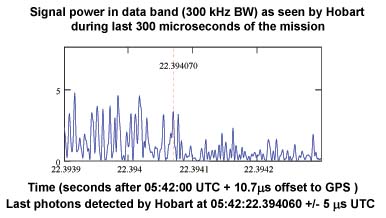
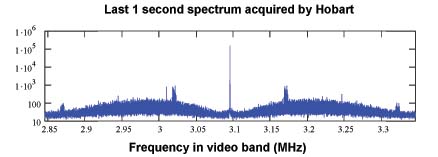
be soon developed like
the tuned bandwidth of 32 MHz with 64 MHz clock output. This mode, if
adopted with 16 CoreBoards, will produce a maximum aggregate data rate
of 4 Gbps on two VSI connectors. Multichannel configurations, with a
reduced number of Core Boards processing elements, are also under
development for future use.
 The
VSOP-2 project which was proposed last year was finaly approved
at JAXA
and then at the highest level governmental space committee.
VSOP-2 budget request
starting from April 2007 was submitted, and the the decision is expected to be
given in the end of December 2006.
The
VSOP-2 project which was proposed last year was finaly approved
at JAXA
and then at the highest level governmental space committee.
VSOP-2 budget request
starting from April 2007 was submitted, and the the decision is expected to be
given in the end of December 2006. 


